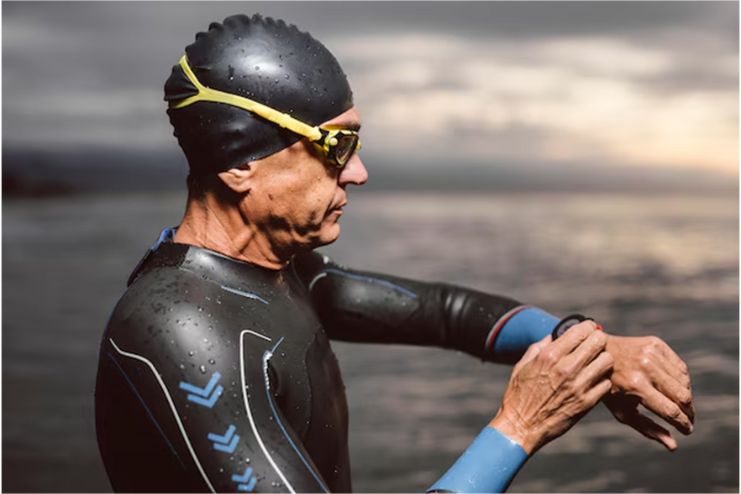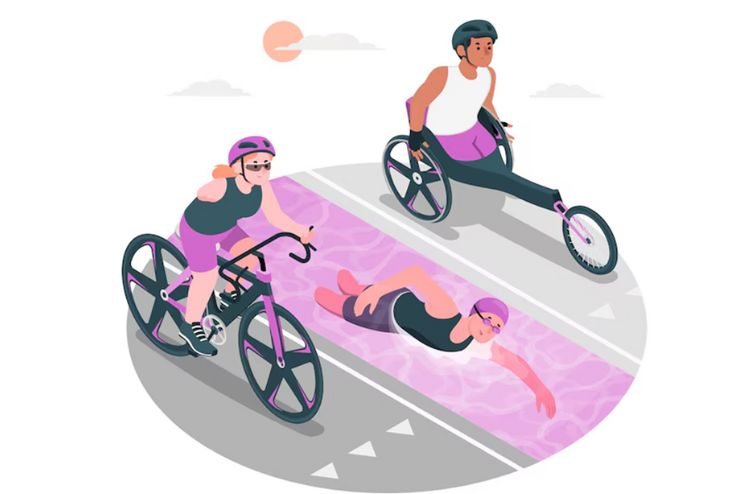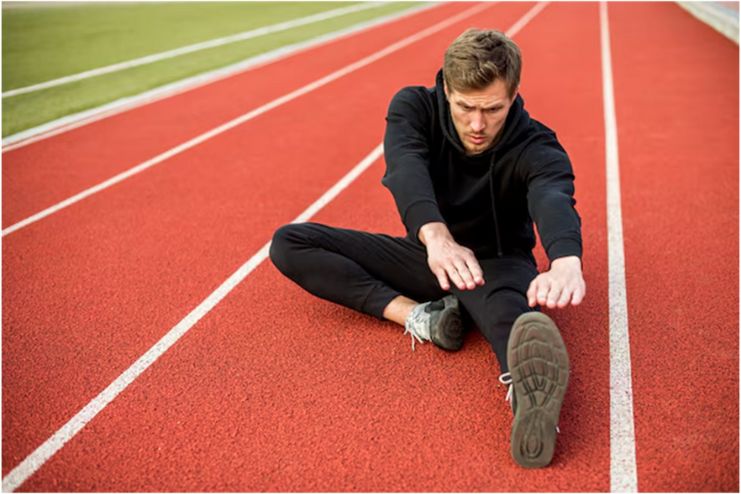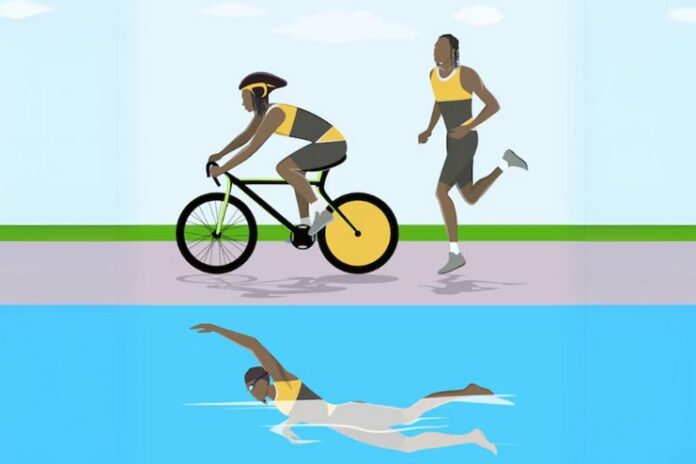AI Contribution
At HealthSpectra, we may use AI to refine grammar and structure, but every piece is shaped, checked, and approved by real people, our expert writers and editors, to ensure clarity, credibility, and care. Learn more..Affiliate Disclaimer
Some links in this article are affiliate links. We may earn a small commission if you make a purchase through these links, at no extra cost to you. We only recommend products we find useful to our readersYou must read this if you love swimming, cycling, or running. If you want to know more about sprint triathlon, the training tips, and the plan, read ahead.
We now know that you’re looking for some triathlon-related knowledge. You are in the right place. This article will help you understand beginner triathlon training tips, beginner triathlon training plans, effective race transitions, and race-day preparations.
What Is A Triathlon?
A triathlon is a multisport race that consists of swimming, cycling, and running across distances. The triathletes compete for the fastest overall completion time. They race each segment in a sequence while transitioning between the disciplines.
Triathletes change equipment at each transition stage between each discipline. Transitioning is equally essential to swimming, cycling, and running. These transitions need detailed planning to save time while ensuring a smooth shift between transitions. You must ace the transitions, as a few seconds can cost you significantly while in the race. That’s why triathletes practice transition drills until they are a pro in switching gears and ensuring consistent performance across all disciplines.
The race is unique, requiring a blend of strength, toughness, and endurance. Triathlons help build physical stamina and improve cardiovascular health.
Understanding Triathlon Distances

Triathlons have various distances, and sprint triathlon is the most beginner-friendly.
- Sprint: A 750 m swim, 20 km bike, and 5 km run
- Olympic: A 1.5 km swim, 40 km bike, and 10 km run
- Half Ironman: A 1.9 km swim, 90.1 km bike, and 21.1 km run
- Ironman: A 3.9 km swim, 180 km bike, and 42.2 km run
Choosing the sprint triathlon is ideal for most beginners. A study published in PubMed suggests that starting with shorter distances reduces the risk of overtraining and injury, which is essential for novice athletes.
Setting Up Your Training Schedule

To gear up for your first triathlon, you must have a well-structured training plan. To prevent overtraining, it is recommended to balance aerobic training, strength exercises, and rest periods.
Here’s an easy schedule to train you for your first triathlon as a beginner. This plan has a progressive weekly schedule that focuses on all the disciplines of swimming, biking, running, and recovery days. The main goal of the triathlon training plan is to gradually build endurance while including activities like brick workouts (bike-to-run) sessions, which are critical for triathlon success.
For example, a typical training week might include:
- Monday: Include a leisurely swim as well as mobility exercises. For example, range of motion exercises like resistance training
- Tuesday: You can try an interval bike workout in the first half of the day, followed by a light run in the second.
- Wednesday: Try an interval run in the morning and a swimming exercise specific to the race in the evening.
- Thursday: Include some endurance training in the morning and strength training exercises in the afternoon.
- Friday: Long swimming only for this day.
- Saturday: Include a long endurance bike ride every other week.
- Sunday: Have a long endurance run
This plan is perfect for beginners who aim to balance their efforts throughout various disciplines. This makes them prepared for race-day transitions. The triathlon training plan aligns with the training principles and gradually avoids overtraining, building endurance.
For triathlon training, the American College of Sports Medicine (ACSM) advises a periodization strategy where you focus your training on different areas at various stages. For example, you can build strength in the off-season and maximum endurance during peak training sessions. You can also include swimming techniques, running at a steady speed, and cycling to build strength. Active recovery on rest days is also crucial for good recovery, performance, and injury prevention.
Building Endurance in Each Discipline
When you start training for a sprint triathlon, you must understand the variety of training you need. Each discipline requires specific training, which helps you enhance your endurance.
- Swimming: Most swimmers face challenges with the swim leg, especially in open water. You can build endurance by following proper breathing techniques and body positions to reduce fatigue. These are the basic tips for swimming for beginners. You can gradually increase your swim distances and practice open-water swims to prepare for the race day.
- Cycling: Building endurance while cycling is a key factor in sprint triathlon. Cycling is about stamina and handling the bike. To gradually build endurance, you can start with flat routes and later on hilly terrains. You must also efficiently train for bike transitions, like shifting gears easily. This practice can put less pressure on you on race day.
- Running and Brick Workouts: Try brick workouts instead of just running. Brick workouts involve cycling followed by a run. This is a perfect way to help your body adapt to the transition between disciplines. You can increase the distance slowly and steadily, followed by speed workouts, which improve your running and performance.
Essential Skills and Transitions for Triathletes
You must have the essential skills to smooth out the race transitions in a triathlon. These transitions are referred to as T1 (swim to bike) and T2 (bike to run). Accomplishing the transitions requires practice, preparation, and correct strategies.
T1: Swim to Bike
- Gear Organization: The tip is to arrange all the gear you need logically, including helmets, bike shoes, and any other equipment, within your reach to save time.
- Efficient Wetsuit Removal: Often, athletes forget to practice removing the wet swimsuit. You must also practice this: quickly roll it down your hips and step out of the pool easily.
- Helmet First: Always wear your helmet before you touch the bike. Breaking this rule might attract fines.
- Bike Mounting: Before the race starts, practice a smooth and quick bike mounting exercise or use the ‘flying mount’ technique.
T2: Bike to Run
- Quick Dismount: Efficiently step off your bike or practice the flying dismount technique while you move toward the transition area.
- Running Shoe Prep: Do not waste time. Opt for elastic laces or pre-loose shoe closures. This makes it easy to slip into the shoes and saves time.
- Hydration Grab-and-Go: If allowed, grab a bottle of water to stay hydrated for the race.
General Time-Saving Techniques
- Transition Walkthrough: Make yourself familiar with the transition area before the big day to have clarity
- Minimal Gear Changes: Keep your clothing changes to a minimum to save time.
- Multi-tasking: Remember to hydrate, dry off, and assimilate your plan and thoughts before the next leg starts.
Nutrition and Hydration Tips

According to Healthline, proper nutrition is important for athletes before, during, and after the race. This includes adequate carbohydrates, which provide the necessary energy for muscles.
Key points about fueling for endurance:
- Carbohydrates are key: Carbs are essential for building energy. Include a carb-rich diet, particularly complex carbohydrates.
- Pre-exercise meal: Maintaining a balance of carbs and protein hours before exercise can maximize your performance.
- During exercise fueling: Consume easily digestible fibers during long workouts to help maintain energy levels.
- Hydration is essential: Stay hydrated, as dehydration can impact muscle function. You must also ensure that you eat a balanced meal of carbs and proteins 2-3 hours before the race. Include healthy fats to improve training outcomes and prevent fatigue.
Gear Checklist for Beginners
Not just training but having the right race gear makes a difference for a beginner. The key essential gears that you must invest in include:
- Wetsuit: Wet suits are a must-have for open water swims
- Bike: You can opt for a road bike or a hybrid one.
- Helmet: Ensure your safety and buy a helmet while you do biking.
- Running Shoes: Choose shoes that help you run comfortably for longer distances.
- Additional Gear: You can buy a few additional items, including sunglasses for eye protection, a race belt for your number, bottles for water, and energy gels for fueling.
Investing in good quality gear can help prevent injuries and enhance your comfort.
Overcoming Common Challenges

When you are a beginner, triathlon training can become challenging sometimes. These challenges are not just limited to physical but are also mental challenges.
- Challenge of Injuries:
You might face this challenge as you train for your first sprint triathlon. By including strength training in your training routine, you can avoid injuries like tendonitis and stress fractures. Cross-training has proven to lower the likelihood of injuries. - Challenge in Goal Setting:
You can and must break down your larger goal into smaller achievable goals. Progressive increase in workout or swimming distances must be celebrated and cherished. This keeps your goal clear and attainable. - The Challenge of Uncertainty:
For this, you must often visualize yourself as a winner who has won every stage of the race. This manifestation helps boost your confidence. - Challenge of Plateaus:
As the training progresses, you might hit a plateau, which might disappoint you. But remember, this is a good chance to diversify. You can include new workouts or train with a partner to regain the lost enthusiasm.
Race Day Tips
The big day is here. You have trained hard for the triathlon, and finally, you witness the sun rising on this special day. This might be jittery for once, but you can ace the race with specific tips.
- Arrive Early: Arriving early can give you ample time to set up your transition area, ensure you have proper gear, and become familiar with the environment.
- Steady Pace: Adopt a slow pace on the swim, maintain a slow speed on the bike, and save as much energy as possible for the run.
- Ace your transition: Practice your transitions well, which will help you save maximum time during the race.
Conclusion: Enjoy The Journey, Ace The Race!
As you train for your first triathlon, you will experience how rewarding it is. The whole journey from where you begin the first swim until the final run tests your strength and builds endurance. Ensuring you have the right gear, the correct triathlon training plan, beginner triathlon tips, a nutrient-rich diet, proper hydration, and recovery will help you ace the race. This is just the beginning; remember to cherish each day of training. Irrespective of whether you are training for a sprint triathlon or a longer run, have fun and give your best shot!
In this Article





















